Goodreads meta-data is 200 pages, over-rated 3.74 by 226 litizens.
Genre: krimi, police procedural.

Verdict: a curiosity of the place and time. A forced march to finish it.
Set in the Swiss alps in the early 1930s when radio was a novelty. A local is found dead. Was it suicide or murder? Everyone speaks Schweizerdeutsch in which ‘Chabis’ is an oath.

Not to be confused with Chablis.
Into this isolated mountain top community comes Detective Sergeant Studer from the distant Canton to find out which is which. He takes up residence and observes the locals. The bar owner. The nursery man and his staff. The family of the deceased. Creditors. Trees. Swains. Rivals. That is something like the Maigret approach but the hands of this cuckoo clock are heavier by far. As far as this reader can report no thumbprint figures in the story.
Masochists can find out more than they should know by reading the thirty reviews on GoodReads.
 Friedrich Glauser (1896-1938) was diagnosed schizophrenic, addicted to morphine, dabbled with heroin, and was intoxicated when he could not get drugs. He spent most of his life in psychiatric wards, insane asylums, and prisons. That experience makes him well qualified, ahem, as well qualified, as most journalists, to comment on the human condition.
Friedrich Glauser (1896-1938) was diagnosed schizophrenic, addicted to morphine, dabbled with heroin, and was intoxicated when he could not get drugs. He spent most of his life in psychiatric wards, insane asylums, and prisons. That experience makes him well qualified, ahem, as well qualified, as most journalists, to comment on the human condition.
There are two or three other titles with Studer. They are unlikely to be disturbed by this reader.
‘The Miernik Dossier’ (1973) by Charles McCarry
GoodReads meta-data is 267 pages, rated by 3.87 by 1375 litizens.
Genre: thriller
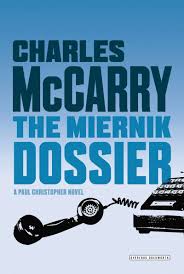
Verdict: Unusual in the telling.
It is deep in the heart of the Cold War of 1959 and the Russkies have their eyes on East Africa. Spy and counter-spy vie to manipulate the natives. It centers around a group from a UN agency housed in Geneva which includes a Yankee doodle, a Polack, a Magyar, a Sudanese princeling, a MI6er, and others who embark on a drive from Geneva to Khartoum. Sure.

While the journey is as fantastic as anything Jules Verne conjured, the characterisations are nicely done. No one is quite whom they seem to be, and yet perhaps they are. Even at the end, it is not at all clear to this reader whether Miernik was a villain, though he certainly was a victim.
What is unusual is in the telling. It reads like a dossier that collects and combines testimony, written reports by observers, diary entries from protagonists, archival material about them, analysis by Langley desk jockeys, wiretap transcriptions, post hoc interviews, radio intercepts, case officer cables, opened mail, entries from the CIA Fact Book, field briefings, and such. While there is a master narrative with an arc, it is by no means told as a story. Though in its own way it is, and the story unfolds in these several different registers. The ending is open, but not empty.
 Charles McCarry
Charles McCarry
This is the first title in a long series featuring Yankee Doodle, namely Paul Christopher. Alan Furst ranks it highly and that persuaded me to give it a try. Not sure, but inclined to try another.
‘UFO: Target Earth’ (1974)
IMDb metadata is runtime of 1 hour and 20 minutes (it seemed longer, much longer), rated a heady 2.4 by 294 cinemitizens.
Genre: Sy fy
Verdict: There is no UFO and little else.
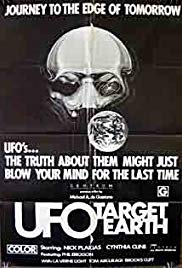
The opening credits are juxtaposed with grainy photographs of ostensible UFOs from the 1940s and 1950s. Then in a prologue we see a journalist with big hair and flared trousers in a double-knit suit interviewing Georgians about UFO sightings and abductions. The interviewees look rural and sound southern. This seemed a reasonable start.
Then the unreasonable set in.
A graduate student, wearing a three-piece suit and necktie with his own office and desk telephone at the University of Gainsville (Florida) makes a telephone call during a thunderstorm and over a crossed wire hears a conversation between a general and someone else about strange goings on.
During this call he has flashbacks to his own childhood in a similar storm, though the exposition is so lame it took ages for the fraternity brothers to realise this was a flashback and not a parallel cut-away. Later these flashbacks might be relevant, but at the time they seemed bad editing.
What to do? He consults his supervisor (bearing a frightening resemblance to what Justin Beiber will become) who wisely tells him to forget it. In the great tradition of student rebellion Three Piece disregards this sage advice, and recruits Mystic to help him get to the bottom of this mystery. Who better than a mystic to deal with a mystery? Mystery? What mystery? The phone call.
He goes to see General, there is only one in all of Florida, who wears an Army-Navy store uniform and who chides him for the liberal ideas of students (in Florida?), and then denies everything. Well he would, wouldn’t he. During this conversation Three Piece represents himself, a lowly grad student, as negotiating for the university. Sure. Even so the conversation is reasonably well written but so slowly executed the suspicion grows that they actors had to be word perfect because their was no dime for a re-take.
It seems there is a long history of electric power disruptions in the area. That the Buford Plant generating station has had some strange accidents. And that the mystic hears voices in the air, and not from a BlueTooth headset.
Three Piece and Mystic trace the voices to the lake. ‘The lake! Gulp. The lake? Yes, the lake.’ This dialogue went on for five-minutes. What they need is proof. Sure, but proof of what? That Three Piece is nuts and Mystic has an ear pod stuck in her lobe?
As darkness falls, they wait. We wait with them. We all continue waiting. That is followed by more waiting.
Then Three Piece also starts hearing voices in the air. He puts on a grey wig like Christopher Lloyd in ‘Back to the Future’ and walks into the lake as the voices tell him he has been chosen, only the fourth to be so honoured in a thousand years. By his sacrifice the world is saved (from the Trumpettes for a time?). We wondered if Virginia Woolf had been so honoured.
The end.
Get it? Get it! No, neither did we. What were we saved from? A sequel?
If the phone call was hot why didn’t the general do something like lock up Three Piece. Like rip his office apart. Like send thugs to warn him off. Like put on reflective dark glasses. Like tell the aliens to look out. Like try to kill Mystic. Come on. This is standard B-movie fare.
Did Florida grad students in 1974 wear three-piece suits? Did scientists team up with mystics quite that readily? Did someone really write that dialogue?
We never see a UFO, nor is there any reason to think that there is one. The voices, well there are other explanations. See a textbook on psychoses for a list.
There are lots of swirling lights to imitate Space Odyssey (1968). Some of the sound track works.
None of it takes us ‘To The Edge of Tomorrow’ per the lobby card. Nor do we broach ‘UFO’s…the truth about them might just blow your mind for the last time.’ Nope. Unblown.
One of the critics linked to the IMDb entry suggests it be re-titled to ‘Target Extreme Boredom’ because it succeeded at that. Amen, chorused the slumbering fraternity brothers.
Then there are the effects, like the boom microphone hanging overhead.
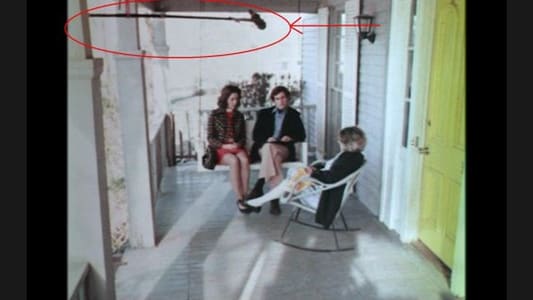
The post-production editing and (dis)continuity render most of it incomprehensible without a script to follow. Hmm. Maybe that would not help.
None of the cast or crew has other listing on the IMDb. Ergo they learned from this experience to go into paediatrics or something.
‘Phantom from Space’ (1953)
IMDb meta-data is 1 hour and 13 minutes of treacle time, rated a generous 4.1 by 818 members of the producer’s extended family over the generations.
Genre: Sy Fy
Verdict: The search for intelligent life on Earth continues, with limited success.
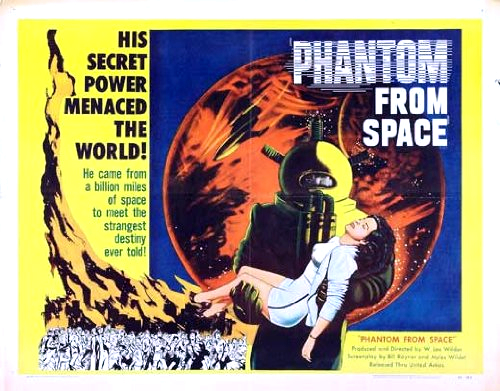
It opens with fifteen minutes of stock footage of radar dishes, screens, technicians who are tracking a flying object, so intones a narrator. The object is making 70,000 miles an hour! It was first spotted over Alaska and then tracks down the Pacific Northwest coast (skipping British Columbia) toward Hollywood. Gulp!
In May 1953 this had to be a Red rover, and not Santa Claus! Stock-footage of F-86 Sabre-jets ascending to meet this Soviet menace! Whoa! Sabres could hit 650 mph. The Red Saucer whizzes past them before the Sabre pilots can buckle a seat belt! What to do! Fear the worst.
Then the flying object slows and drops off the screens near Santa Monica Beach. Nice place.
As this latter event occurs we cut to citizens who find radio reception has been jammed. Some of these citizens go on and on about what they wanted to listen to on the radio. And on. All that jabbering galvanises the Federal Communication Commission to action. (As if.) Its technical vans, recognised by their revolving roof-top antennas drive around Griffith Park while the crew talk to each other. A lot of driving and a lot of talking.
By this time the fraternity brothers were dozing on the sofa. ‘ Zzzzzzzing’ is a direct quotation.
Then a frazzled woman lurches in front of one of the vans and says she and her husband along with a friend were attacked by a man in a diving suit. The technicians leap into action. Yep, they talk some more, but they do radio in the alert and a call for an ambulance. Their radio can, it develops, send but not receive now, like some people. The intermittent radio trouble is well handled in this scene.
Ben Casey’s offsider working his way through medical school as a police officer arrives. Lights up. He finds the husband dead. Story is he picked up a club and swung at the Diver (Phantom to the cognoscenti) who shoved him down, fatally. Cops aren’t buying the malarky and conclude the friend killed the husband for the wife. In a touching bit of dialogue the police keep calling this friend ‘the young man’ when he looks about forty. (He is not listed in the credits so no check is possible.)
While the cops are fabricating a case against ‘the young man’ there is a break-in and fire at the Getty oil refinery. Someone was killed in the fire. But it seems it was started by accident.
At minute 27 second 43 we get the first glimpse of a figure running around the oil refinery in a onesie. This must be Phantom! About time!
The audio had to be turned up to be heard over the snores of the fraternity brothers at this point.
By now the ambulance medicos, army, police, and feds are mobilised in a one camera frame shot, squeezed together, but none of them make any connection between
1) the disappearing Red Saucer,
2) the radio interference, and
3) the Diver.
Instead they grouse about the bad coffee.
Back to the Getty oil refinery. They chase after Phantom in the diving helmet and onesie. Then poof! He goes invisible. Every producer’s dream. He strips off his onesie and helmet and voilà nothing! Instead, wirework opens and closes doors, windows, spins chairs and so. Invisible he eludes the posse. Invisible he eludes a pay-cheque.
The cops, army, medics, and Feds finally realise the obvious at minute 47 second 5 that all three events above are connected. They take the onesie and helmet to Griffith Planetarium to be analysed. Guess they want to hold it up again the stars or something. In the lab (sure) is a woman scientist with her pet dog, Venus. Pay attention because these two are the only ones with any sense. She finds the suit radioactive and dons kitchen washing-up gloves to handle it. This was the official Atomic Energy Commission line at the time. Radioactivity was like poison ivy. Don’t touch.
The helmet, however, is not hot, but its breathing apparatus has unknown gases in it. Hmm. They sit in a cramped office and talk. Talk. Talk.Talk.
Periodically Phantom returns to the lab to inhale some of the helmet gases while the crew sits next door talking. Talking. Talking. Talking. By the way, contrary to rumour one fraternity brother stayed awake and counted forty-seven cigarettes lit by the onscreen cast. During some of the talk all of them are puffing way in a cloud.
Ah ha! There is an ‘Ah Ha’ moment. They will set a trap for Phantom. They set up the Planetarium with invisible eyes on all the outside doors to give alarm when he enters. What if Phantom is already in the building is a supposition none considers. Why they do not use the helmet as bait is down to their stupidity. Into their trap wanders the elderly and annoying journalist after some cheap sensationalism. Nothing has ever changed.
Every time Phantom is present Venus the dog goes ballistic but no one pays that any attention. Yes, Phantom is searching for intelligent life on Earth and so far only the dog passes the test.
While the men smoke and talk, talk and smoke, the Dr Woman goes back to the lab to pour stuff into vials. Phantom comes in for a helmet dose. Now get this.
What is B-movie woman supposed to do at this point? Scream. Faint. Trip. Scream. Faint. Trip. Those are the choices. NOT SO HERE.
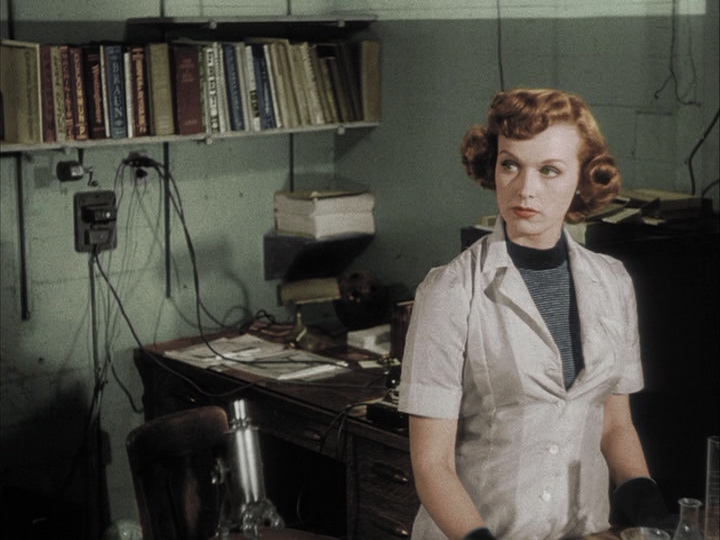 See, she keeps a cool head.
See, she keeps a cool head.
She is frightened when the helmet floats in air, but keeps calm and tries to communicate with the being! She also discovers that he becomes visible in ultra-violet light. She is a thinker. Another one passed the intelligence test. Both females, Venus and Woman, one dog and one not.
Needless to say the lads are unhappy about being shown up and to prove their manliness they set out to chase Phantom around the Griffith Planetarium for about fifteen minutes. We see repetitions of this footage five times. Then bored to death, Phantom runs out of his air and dies.
The end.
Well, it could have been worse. On the bright side, John Agar was not in it. Despite the zero budget it had some good special effects. When the Phantom carries Dr Woman off it is spooky since he is invisible. (In a black suit suit against a black matte.) When Phantom becomes partly visible under the ultra-violet light is good, too. Dick Sands who did the stunt work as the Phantom is good at running, jumping, tumbling, and falling. He does not speak and that saves him from the terrible dialogue.
One of the great moments in reasoning occurs when the talkers, conclude that because Phantom is invisible he must be silicon like glass. Tweet that. Who needs the National Science Foundation with brainwork like that.
It just ends, leaving nothing. There is no conclusion. No explanation. No expectation. No one wonders why he came. What he wanted. Where did he park the Red Saucer on Santa Monica Boulevard. Was he really a Russkie under all that white pancake make up. Nothing. Nada. Zip.
The lobby card is as erroneous as these usually are, written as they are by journalists. Phantom seems to have no power. He does not menace anyone. He was attacked by the husband and defended himself. We have no idea where he came from or why. No one checked the odometer on the saucer. Maybe he came from Outer Schenectady.
W. Lee Wilder produced and directed based on a screenplay by his son Myles Wilder. Yes they are kin of Billy Wilder. Elsewhere on this blog I have reviewed others of Lee Wilder’s oeuvre for which I did homework on the relationship to Billy. See the review of ‘Snow Creature’ (1954).
To some jaded viewers, among whom your correspondent takes a place, it seems the Widers saw ‘The Day the Earth Stood Still’ (1951) and set out to imitate it with a benign alien. But like someone trying to recite poetry phonetically in a foreign language, he had no idea how to intone, phrase, and colour it. Instead it is just a blurt.
The zero budget is reflected in the use of Griffith Park and the Griffith Planetarium which were readily available for filmmakers for years until the welcome mat was worn out. The cramped office scenes were shot in Wilder’s one-man office. Most of the extras were walk-ins recruited at a cattle-call.
‘Blake’s 7’ (1978-1981)
IMDb meta-data is 52 episodes of 50 minutes each, overrated 8.0 by 2712 cinemitizens.
Genre Sy Fy.
Verdict: Improves after episode 1.1 thanks to writer Terry Nation but pales then without Terry Nation.
The director(s) need masterclasses from Val Guest. It is evident more money was invested in Seasons Two to Four in costumes, sets, and stunts. Then it goes on and on without Blake and without ever making it to seven.
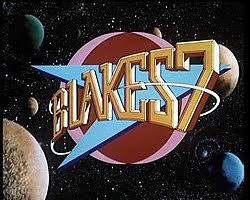
It first aired the same week that ‘Star Wars’ opened in England. There are similarities and differences. The technical effects of ‘Star Wars’ outstripped everything at the time including this.
The similarities are in the story. Both feature a small band of righteous outcasts who challenge a behemoth. In the case of ‘Star Wars’ the band members cooperate, some friction aside, and prevail over the mighty, whereas in ‘Blake’s 7’ the members quarrel constantly, to the point of tedium, well, far past the point of tedium, and lose slowly but inevitably everything (including viewer interest).
The sequence of my viewing got jumbled but that did not seem to matter after the second season when any sense of a quest with a chronological order was lost and it reverted to swords and sandals in space with a new wardrobe each week. Blake departs but the name stayed.
In the far future (or past) the Terran Federation is a nightmare of McKinsey Micro Managers with Macro tasers. Things are worst on the home world of Earth where it all started. There micro-management involves brain washing. Today’s managers can only dream of this, and some do.
Malcontents who failed 360-degree reviews, missed the KPIs, or used plain English instead of deracinated McKinsey-speak are consigned to transportation to Au-star-lia in the far distant Botany Way. En route the prison ship encounters a Marie Celeste spaceship of an unknown design and it is big. Space is always crowded. Cannot go anywhere without running into an obstacle.
The Big Ship is ominously silent and the first boarding party goes that way, too: Silent. The captain of the prison ship decides to use some expendable prisoners to explore and secure the ship. Genius! He sends Blake because he is a pain and might get toasted; Plucked Eyebrows because she is a pilot who could steer it; and Nasty because he is a computer plumber who might be able to start it. Of course if they succeed ….
Thanks to his heroic self-control with which the script endows Blake, he zaps the self-defence systems of the Big Ship, whose computer then politely introduces itself as Zen, Siri’s cousin, and the ship as Liberator, and off they go.
In this case, bigger proves to be better. BIG disappears, leaving far behind the prison ship and its many keyboards which the actors pound with hammers. The prison ship captain is sure now to fail his 360-degree review. Gulp!
Blake has two then. ‘Blake’s 2’ did not cut it as a title. The fraternity brothers thought it could be ‘Blake’s 3’ by counting the man himself. Not so, a higher authority ruled. Blake’s One does not count. That one is covered with just the word ‘Blake.’ There are many convoluted discussions in the cyber world about this very deep and perplexing question. Abandon syntax all who would plumb those depths.
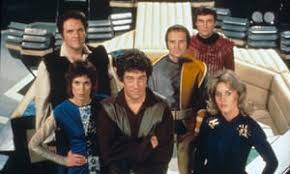 Blake and five makes six.
Blake and five makes six.
By the way, the opening title card from Beeb above has no, repeat no, possessive apostrophe. It reads ‘Blakes 7.’ In fact it reads ‘Blakes7’ without a space between the word and the number. Grammar, too, must be abandoned it seems. Some wits and wags say those omissions were due to budget constraints. Neither apostrophe nor space could be afforded. Silly? Maybe not. If the title card and publicity material were done by mistake without the apostrophe and space, the budget might not have been sufficient to do them again. The IMDb in a rare display of grammar has inserted an apostrophe and space on its entry for this series which reads ‘Blake’s 7.’ As did I above.
The pilot seems willing to do what Blake wants. (The fraternity brothers made several suggestions.) Nasty wants to… be…nasty. They decide to follow the prison ship to the prison world and rescue any other prisoners who want to come along. Why? Because the title calls for seven, that is why. Yes, Blake says it takes seven to fly BIG but in fact there are never seven at a time on BIG. Moreover, every time something comes up, they run back and forth to the controls. It is clear to everyone but Blake that more than 7 are needed. However, often the ship, with Zen at the helm, flies itself and 0 are needed. At no time are there seven (7) on board flying Liberator.
These three show no curiosity about BIG or its absent crew, but find plenty of wardrobe that just happens to fit each of them. Go figure. The threads by the way are strictly Robin Hood. At least they are not flared trousers. No one stops to think that may BIG’s people will come looking for it with BIG things. This they do in the opening of Season Two with decals stuck on their foreheads and even worse dialogue. It is this episode the Nasty says, ‘Beam me up!’ Whoops. Ditto in this episode Blake says we call the ship ‘Liberator.’ Read the script, lad. Zen told you the name of the ship was Liberator in episode 1.1. It calls itself that. And the interrogator, even without a waterboard, should have already known all that since they came to reclaim the ship. Does anybody reads the syllabus, eh, script?
Thereafter they argue among themselves as their number increases toward but never attaining the magnificent but elusive seven. Mostly the tension is between Blake who wants to subvert the McKinsey Terrans with rebellion and Nasty who wants to enrich himself. We have action man who wants to blow things up versus the hacker. Blake’s merry band includes a strong man who can throttle villains two at a time, a cringing coward who can pick locks, a rebellious young woman who wants to do things her way, and someone I have forgotten. Or should that be two? By Season 1, Episode 6 they are Blake and four others.
Is Siri, the talking computer Zen, number 7? Stay tuned to find out! I did, stay tuned, and I didn’t, find out. Later we have another talking computer.
They are opposed by passing pirates, nut cases, Brian Blessed as a crazed Holy Roller, and pursued by McKinsey Operatives with Power Point lasers and training modules. Though these official pursuers are easy to elude because they wear blinding head gear which they only remove so they can clonked on the head.
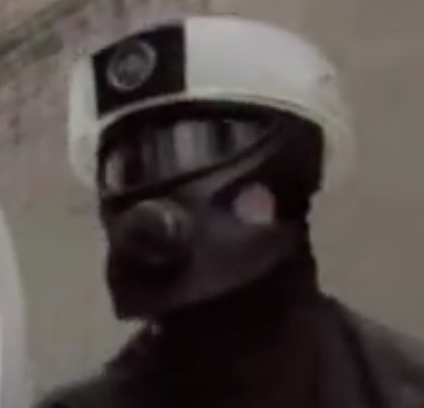
If the director ever lets them take off those tin cans, Blake’s Seven will be None, Zero, Nada, Gone.
Blake emotes over microbes, broken pottery, litter on the spaceways, and is always going out of the way to get into trouble as required by the script. He is Mother Teresa in space.
The characters do not change though some are killed off and others just disappear. The pilot continues to do as told. Nasty remains nasty. The coward cringes when a draft blows. The strong man rips the top off tins when a can opener is handy. Blake emotes. It is all predictable. Scanners reveal a banana peel floating in space. Blake has to stop and collect it in case a passing ship slips on it. Nasty objects that doing so is a waste of time. Wimpy hides in case a chimpanzee comes looking for the banana. Pilot does as told. Petulant female pouts. Strongman stomps on it. The end.
By the end of season four only Nasty and the Coward remain from the original crew, a]having repeated their paper thin characterisations fifty-one times.
Strangely, Blake is in less than half the episodes. The question then is, who does the emoting if he is not there? When he is absent the crew goes looking for him but not very hard. Maybe he got a better offer, I know I did. Should the title have change to….? ‘7 without Blake?’ Or, how about, ‘Blakeless7.’
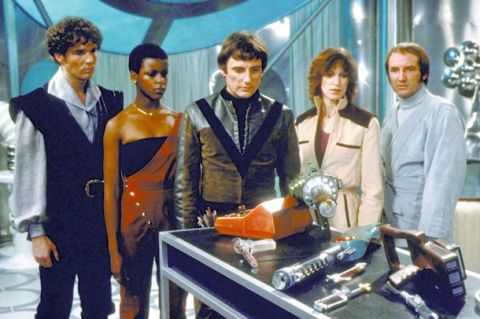 Five without Blake.
Five without Blake.
Most episodes of the first two seasons are bleak, and the fraternity brothers proposed it be renamed ‘Bleak 7’ and obviate the need for an apostrophe. There is never have a Zorro moment, and they leave a trail of destruction behind them, despite their intentions. The distant, space-powered future is worse than today. In most episodes they encounter malign beings and occasionally they turn on each other.
By the by, Nasty is called Avon. Yes he is. And yes he does….once, say into the communicator ‘Avon calling.’ I waited fourteen episodes for the moment. But it was anti-climactic, because Paul Darrow says it like he means it. What an actor! It became his show when Blake went missing. But how can Nastyman carry the show. Answer, he couldn’t.
There are some interesting ideas sprinkled throughout, and occasionally some fine acting. Ideas? The chair sized computer shrank itself to fit into a pocket. The idea that a universally used computer chip in the Federation can be hacked by the largest portable computer ever seen, Oric, was prescient. However in the kickoff to Season Two when The System comes to reclaim Liberator it seems computers there also use that chip. How can this be since this is the first contact between the Federation and The System is anyone’s guess. The fraternity brothers were sure of this, because those forehead decals are memorable.
While the fount, Wikipedia, reports a steady fall in audience from Season One to Two, the budget increased as evidenced by the every more expensive wardrobe, costumes, and stunts. The designers were also called to create new sets for new villains. The money went to these superficial bibelots and not to screen writing. Terry Nation’s name is seen less often in the credits. At one point it seems the script writer also plays a part. Never a good idea.
Good acting? Well, none of the regular and fabled ‘7,’ if ever that number was reached qualify largely because the scripts give each of them only one note, but Space Commander Travis in the first season has some moments in the last episode of real complexity. However this actor was replaced by Travis II who is one-dimensional. Avon certainly tries to inject gravitas into the limp scripts.
Blake had a long career in Brit TV, including — of course — ‘Midsomer Murders,’ but this series is listed as one of his three ‘Known For’s’ on the IMDb. Since it is virtually unknown that is little consolation.
I watched some of the early episodes at the time with only a vague recollection, but I did not follow the series to the end. That was not an aesthetic decision but a result of travels on sabbatical 1979-1980.
‘Dead Lions’ (2013) by Mick Herron
Goodreads meta-data is 4.2/5 by 2745 litizens.
Genre: Thriller diller.
Verdict: The study in organisational pathologies continues.

We used to teach something call Org Theory which bore little relation to Org Practice. This book does. Anyone who works in a large organisation will recognise the pathologies exhibited by many of the characters.
The set-up? Two of the Slough House crew are seconded by James Webb, known as Spider, to provide purely nominal security for a visiting Russian tycoon. Why two slow horses for the job, oh, because there is flap on at the Park. Something about office furniture. As always there is never any paperwork to justify the assignment. No paper trail for the FOI rats to find.
Why did I find it credible that a mighty organisation like the Secret Squirrels of MI5 might grind to a halt while an argument with accountants about office furniture takes precedence. Goal displacement comes in many forms. Of course, the furniture is only a means. The end is for two ambitious opponents to fight for supremacy within the organisation. The battle ground? An Eames chair.
Both of the slows, Min and Louise, hope this assignment might restore them to the shining light of the Park, ending their tedious exile to the outer darkness of Slough House, which per the earlier review on this blog is neither in Slough nor a house.
Webb is counting on that motivation to preclude them asking too many questions about this verbal secondment. In meeting them directly he bypasses the supremo of Slough House, Lamb.
There are so many wheels within wheels that my head got in a spin. Rather try to unravel that I offer a few remarks. Nit picking perhaps.
One of the salutary lessons is how easy it is to be fooled if one wants to fooled. Webb’s bit on the bait after reading all about the Russian on the Russkie’s web site. He found there flattering portraits from the ‘Financial Times,’ interviews in ‘Der Spiegel,’ and testimonials from here and there. He looked no further. It was not until Tech Boy Rod cross-checked these excerpts on the Russian’s blog with the original sources that Webb learned, much too late, that they were fake news. There were no laudatory accounts on the pink pages of the ‘Financial Times’ nor in the Gothic script headlines of ‘Der Spiegel.’
What have teachers said since Odysseus returned? Check the original to see if there really was a horse.
Webb did not verify anything because he dearly loved the idea of doing a favour for major player in Russia, a favour that could be cashed later. Ergo, he saw what he wanted to see and nothing more. In his case a successful deal would lead to a promotion up the greasy org pole. Once promoted he would move on away from any fallout anyway.
That is the other lesson. Later when asked who set up the contact, Webb tried to make it sound like his initiative. It wasn’t but he wanted the credit for spotting the possibility of indebting this fellow. When finally he later reluctantly admits that the Russian contacted him first, the tale takes on a different light. It seems it was Webb who was being reeled in and not the Russkie.
 The London sky line these days.
The London sky line these days.
Back to those nits, I found it hard to believe that Dickie would spot the hood quite that easily after all those years. Equally hard to believe was that Dickie did not wonder why it was so easy. Likewise that hood’s boss had lived quietly in England for nearly twenty years seemed a stretch, and in two different places. Even more so the villain’s faith in the dead lions, of whom in the end we learn nothing.
There a few more quibbles but that is what they are quibbles.
Less and less in writing is one legacy of Prime Minister Tony Blair, or so I have been told by a one-time inmate of Number Ten. In that administration, verbal communication became the order of the day to avoid written records. Freedom of Information applies only to what is in writing, after all.
‘Star KnIght’ (1985) or ‘El Caballero del Dragón’
IMDb meta-data is runtime of 1 hour and 30 minutes rated 4.1 by 529 cinemitizens.
Verdict: nice premise with a certain charm.
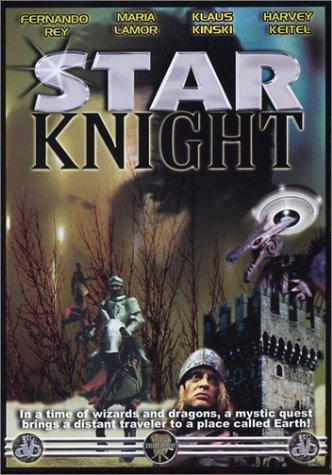
The set-up? It is the 13th Century in medieval Europe. Alchemy and Catholicism vie for the patronage of the local Duke, who has a comely daughter. Little Harv wants to be a Sir Knight but isn’t. He affects the chivalrous speech and manners of such a knight, badly. He is called Klever but isn’t. Even the fraternity brothers got that one.
To pay taxes to the Duke, the peasants expect him to protect them from, say, a passing dragon. One passes overhead. Yikes!
The Duke seeks the counsel of Priest who prays, and Alchemist who gathers data. Then Daughter goes missing. Presumed dragon-meat. Duke offers big reward for her return, including her hand. Vlucan logic that. Bring her back and I will give her away.
Harv puts inserts into his shoes and sets off to rescue her, and garner the aforementioned, including her hand, and more.
Thing is, the dragon is a space ship with one occupant, Alien, who goes around in a spacesuit which is taken to be a suit of armour. He is a harmless lad. He swoons for Daughter and she reciprocates. He has to remain in the suit, and he does not speak but glows and murmurs like a puppy. She reads his mind, and he hers. Not too hard. Well…. [had to quell the fraternity brothers on that one].
Priest is more interested in displacing Alchemist than he is in getting back Daughter. Alchemist is curious and befriends Alien and manages things to bring Daughter back, saved by Alien. This turn of events royally displeases little Harv and Priest who contrive to enter the spaceship which takes off to the stars with them on board bickering, as Harv says, ‘All I ever wanted to do was to get ahead in the world!’ And now he is out of this world.
The End.
What’s to like. The premise that an alien space ship might appear in medieval Europe. Why wait for Area 51 in 1947. That the spaceship might be mistaken in the night and in the mist for a dragon. That a space-suited Alien might be taken for a knight in armour. The rivalry between the witch doctor Priest and scientific Alchemist. The Daughter and Alien are charming. It is daring that the Alien does not ever speak but he looks beatific.
Not so likeable is the slapstick humour of Harv falling over his first friend. The recurrent and pointless Green Knight who is there to remind viewers of Monty Python.
Wasted is Fernando Rey as the Priest. Klaus Kinski is the alchemist and to see him smile benignly is to be very afraid.
As the original title indicates this is a Spanish production from Barcelona. It has an element of Don Quixote with the knight jousting with the spaceship.
‘Santa Evita’ (1997) by Tomás Eloy Martínez
Genre: Fiction
GoodReads meta-data is 416 pages, rated 3.8/5 from 1573 litizens.
Verdict: Quite a ride. Best to have a scorecard of the names and places.

The novel offers an examination of the place of Eva Perón (1919-1952) in the soul of Argentina and Argentines. Eva is dead. Long live Evita!
While there are retrospective glimpses of young Eva growing up, meeting and marrying Juan Perón and ruling with him, and her earlier career on radio and in films, most of the book concerns her afterlife.
When she died Perón went through the stages of grief, culminating in the plan to build a giant mausoleum to her memory. Barely had the ground been cleared in central Buenos Aires for the building when Perón was toppled in yet another military coup. (For what it is worth he won the popular vote in three elections.)
The plotters were at odds among themselves in every way but united in one. Above all else every trace of the Peróns, both of them, had to be erased immediately, least their followers, who were undoubtedly the majority of the populace, rally to the remaining symbols. Street signs, building names, charitable foundations, orphanages, schools that bore the name Perón, all of these had to go. Over night school teachers were required to mark out their names in every scrap of instructional material. Republicans have been doing likewise regarding Obama.
 The youthful Eva.
The youthful Eva.
No symbol of Perónism was more important than Eva herself. At her death Perón had set about having her mummified like Lenin and to be put in a glass sarcophagus on display to the faithful. He had seen the thousands come to mourn her as she lay in state, and since there was demand he set about supplying it. Work had begun on that. There was also a nascent plan to produce wax replicas, least the body decay despite the preservation. Remember Jeremy Bentham?
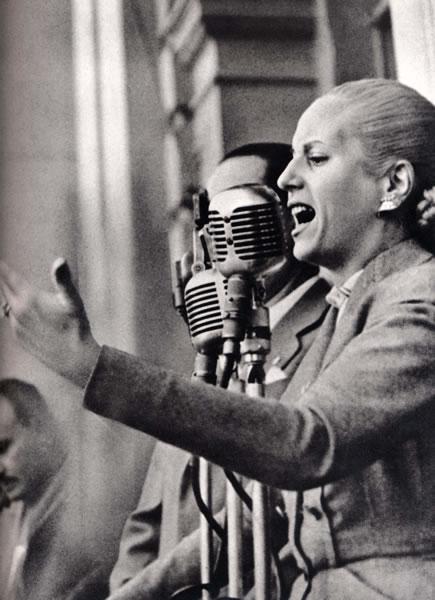 She spoke.
She spoke.
 They listened.
They listened.
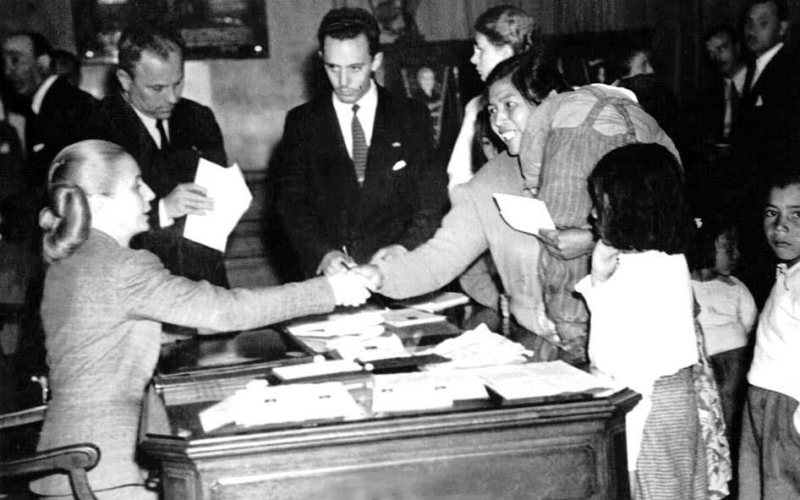 They came; she gave.
They came; she gave.
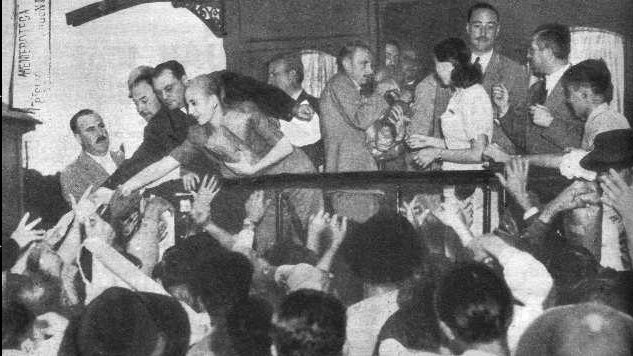 Even the touch was enough.
Even the touch was enough.
Some of this work of preservation had been done in secret and later amid the turmoil of the coup which was followed by an in-house palace revolution by another faction. Moreover some of those trusted with the cadaver tried to hide it from the usurpers. When usurpers found it, they in their turn tried to hide it. In short, the body got lost for many months. When it was discovered the new regime was in a quandary about what to do with it. Unsure even if it was the real thing. More hiding followed.
To desecrate it would call down the wraith of the Catholic faithful and the electoral majority of Perónistas. To bury it would create a site of Perón pilgrimage. To hide it indefinitely in a time of coup and counter-coup would not suffice. To comply with Perón’s plea from his roaming exile to send the body to him would put a potent symbol at his disposal.
From these chemicals Eloy Martínez compounds quite a story as he enters into the minds and souls of the morticians, embalmers, army officers and soldiers, on-lookers, janitors, true believers, by-standers, journalists, and foreign diplomats who come into contact with the mystery train transporting the cadaver or one of its several replicas.
To summarise what cannot be summarised, thinking takes time and initially during the thinking time a squad and a colonel, low enough in rank that he could not reject the assignment, drive the cadaver in a coffin around in a truck from place to place, phoning in for more orders. This becomes a truck of Otranto as the six men keep to themselves, park in deserted streets, eat army rations, skirt cemeteries, and begin to think Santa Eva is watching them from the coffin they transport, the coffin which they must not open, but which…
When the truck is parked overnight, and a careful watch is set, yet the next morning the truck is surrounded by flowers. Or when they turn into a blind alley far off the beaten track to park for the night, when they open the doors to get out they find the alley is now illuminated with candles. Spooky. Thereafter the colonel is obsessed by the body.
Meanwhile, others took charge of her personal effects and papers and in pawing through them come into vicarious contact with the Argentines she touched. There is no doubt that she was a miraculous saint to millions, one who brought material succour and, more importantly, spiritual hope. It is all there in the letters she received from individuals and the letters she sent in reply. This is charisma.
In death there are sightings of her in the valleys, pampas, deserts, villages, barrios, hills of Argentina. The rumours spread. Since there are no facts to contain the imagination, the rumours grew. If a sighting was reported in a village in the distant mountains, within a few hours a host of peasants was on the road making for that village. If a bundle of cash was bestowed anonymously on an orphanage the dead hand of Eva was credited. When the national soccer team scores a goal against the odds ….., and so on.
Dead Eva Perón was beyond price and dangerous beyond measure. Dead she was omnipresent and omnipotent.
The replicas are as dangerous and priceless as the cadaver and in the hysteria, miasma, fear, exhaustion, and confusion of the time, those responsible for the replicas and the cadaver themsevles become uncertain about which is which.
The novel is set out as the author’s report on his effort to write a book on this subject, and some of it takes the form of interviews years later with participants or their relatives, or the discovery of diaries kept by participants, old newspaper cuttings from villages in Tierra del Fuego, letters and documents as officials pass the buck, censored television footage, interview transcripts from the time, radio tapes, and so on. Much is fact, most is fiction.
At time the author breaks the theatrical fourth wall and addresses the reader directly. He also passes comment, droll and disparaging on Andrew Lloyd Weber’s abomination. Likewise he makes short shrift of Juan Luis Borges attempt to crucify Eva.
The grip the woman had on the soul of Argentina and Argentines is the theme. And that grip included both those who loved her in their millions and those who hated her in their millions. Together these millions were as one in their complete preoccupation with THAT WOMAN. Both get plenty of space in these pages.
 Tomás Eloy Martínez
Tomás Eloy Martínez
I seem to have had a Perón spree, starting with Joseph Page, ‘Perón: A Biography’ (1983) and then Eloy Martínez’s ‘The Perón Novel’ (1999), both reviewed elsewhere on this blog, and now this. Eva is much present in these two titles, but I wanted to read more. I did watch the A&E biography on You Tube, which was basic but not as bad as some of the illiterate comments say. Then we were given tickets to see ‘Evita’ later in the year and I decided to do some homework on Eva, starting with this one. I have one more to go, ‘The Adventures of the Busts of Eva Perón’ (2004) by Carolos Gamerro.
I read Jeane Kirkpatrick’s ‘The Perónist Movement in Argentina’ (1971) in graduate school and it left me with a curiosity about Argentina. What she argued was that historically the army made Argentina and that despite its many later corruptions and failings it remained the only legitimate institution in the society. ‘Legitimate’ means being accepted by the populace.
When I referred to a scorecard above the meaning is that it helps to know the players, some of whom I have learned of through the reading above. To read it based on Lloyd Weber, well don’t bother.
Every military coup in Argentina was justified on the ground that it would bring stability. A coup was followed by a counter-coup in one case by a single day and in another by a month. No military government lasted as long as the term of an elected government. Civilian governments, said the army officers, were unstable. The duty of the army was to bring stability. This it did in an endless parade of coups and counter-coups, sometimes between the services, Navy, Air Force, and Army, and sometimes within the Army. They shot it out, bombed Buenos Aires, and fought it out again and again. Stability is a hard thing to get out of a gun.
‘Quatermass’ (1979)
IMDb meta-data is a total of 3 hours and 24 minutes in four episodes of fifty minutes, rated a scant 7.1 by a scant 558 cinemitizens. Scant squared is….
Genre: Sy Fy.
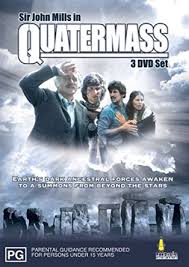
Verdict: Nigel Kneale in top form!
Professor Quatermass leaves the hibernation of his emeritus-cave in Scotland the Brave to get his sideburns trimmed by his missing granddaughter. He hasn’t been out much in the last thirty years – check those sideburns. He has to turn sideways to get through a door.
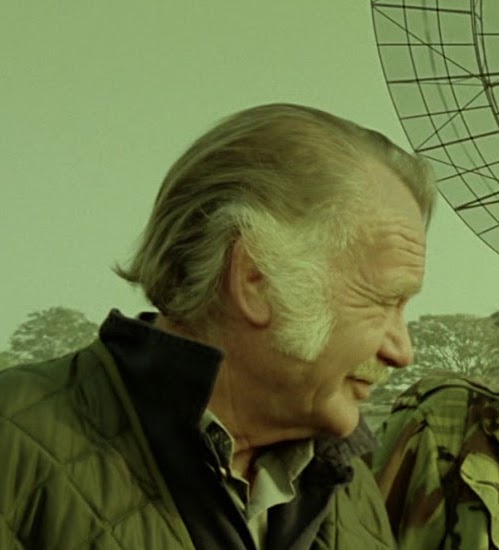
He finds the world is on the verge of chaos. Gangs roam the streets pillaging, beating, and raping (off camera). They also make war on each other and the cash cops, loved that phrase, let them get on with it. Think Clockwork Orange. Garbage is piled in the streets. Abandoned cars are strewn about. Petrol is not available. Public services don’t. Electricity cuts are recurrent. Hospitals turn away patients. Police are the problem, not the solution. Think London in 1982.
Instead of Hippies we have anti-vaxxer Planet People who wander around in tie-dyed saris waiting for the alien space ships to land and rapture them away to a better world. In their eyes Earth has been corrupted by science, by government, by J J J Radio, by hot water, by knowledge, by books, by thinking.
They are proto-Trumpettes with waistlines.
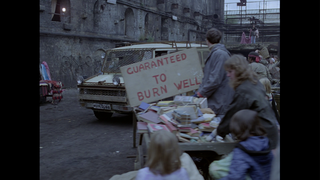 A Planet People library.
A Planet People library.
For now the old order hangs on, barely. Cash cops try to quell violence with the tried and true policing method of more violence. Scientists keep looking for solutions down microscopes and up telescopes. No cure for stupid can be found under glass. That is where Prof Q comes in. What? Is he an expert on stupid? That would put him in demand.
The crumbling regimes of the USSR and the USA are combining to build a space station, and given Prof’s previous experience with space (and aliens) in The Quatermass Experiment (1955), Enemies from Space (1957) and also Quatermass and the Pit (1958), all reviewed elsewhere on this blog, he is invited to comment on a television panel show of talking heads – groan! In the hall of mirrors of the media journalists interview each other and as an outsider Q is made to feel it. Some things never change.
John Mills is the sort of Prof Q writer Kneale wanted all along and he finally got his wish here in the last entry in the cycle. Eccentric, slovenly, confused, unkempt, indecisive, exhausted, just the man for the job. At the television studio he hooks up with Joe, a young astronomer; in the bucolic countryside Joe has a research team and family cowering in a bunkered observatory with voltmeters and CRTs galore. Who they are and what they are doing is left buried in the abyss of backstoryland, unless it was explained during a rest stop.
The Planet People are everywhere, stealing food, using parks as latrines, making trouble, leaving rubbish behind — a lot like dedicated Greenies in Camperdown Park today — and not above killing when a weapon is handy. These Hippies may have flowers in their hair, but they also have gats under their ponchos. They hear voices that tell them what to do, and they do it beyond good and evil. Starting to sound relevant? Tune into to the Russian-sponsored evangelical TV channel for an update.
The highest rating program on the television channel features amateurs in rubber suits hitting each other with sticks. Just caught a glimpse of the very same this morning on Australian Spartan, Ninja, Clown, Warrior or something. Prescient as usual is Kneale.
Prof Q and company are completely at a loss to understand, explain, comprehend, or communicate with the Planet People, though they try with evidence, argument, and reason. Huh! Two different species encounter one another in mutual incomprehension and contempt, young and old, Republican and Democrat. Isn’t this a story for our times?
Those efforts are as successful as negotiating with a dog or a Republican. Whoops, maybe that is an insult to canines.
The Planet People are scary and silly all at once.

They use plumb bobs on strings to follow lei lines and gather for raptures in the sunshine, repeating vacuous phrases, waiting for the Tweet in Chief to raise them to the orbs. Several hundred gather at the Ringstone Round, a small and fictional version of Stonehenge. They chant. The BO index matched Woodstock. This is an England without rain.
In the interim, the Soviet-American space station blows up. At the same time, instruments on Earth go awry. Because communication is so hard, it takes a while for the connection between the events to be made.
Then at Ringstone Round the gathered crowd is vaporised. Poof! Despite the remains of some dead bodies, this vaporisation convinces the other Planet People who were nearby that the rapture has occurred, but they missed it because they were a few yards too far away. Disappointed, they will have to wait until next time. As the sage said, there is no cure for stupid.
By rapture they seem to mean being whisked away to a better world. How the whisking will occur is beyond understanding. That is its glory. Etc. Etc. Etc.
Nothing will shake their beliefs since their beliefs are based on nothing. See, it has contemporary relevance.
The evidence of their own eyes is explained away because aliens work in mysterious ways. Kickalong is their voice and he is perfect at it. However I would have cast Patrick Mower, who is unequalled in exuding energy and malice.
For the bigger picture on all this see Leon Festinger, When Prophecy Fails (1956), reviewed elsewhere on this blog.
The vaporising convinces Prof Q and company that an incomprehensible Dark Force is at work killing these people. Dead is dead for them, and not immigration. Cryptic news from around the world indicates other vaporisation have occurred on ever larger scales. And there, too, the mass vaporisations have encouraged others to line up impatiently for their turn. Imbecilic yes. Credible, too. Lemming-like, too.
Q and company consult the voltmeters and stare meaningfully into the CRTs. The fraternity brothers were making lists of candidates for such raptures, starting at the top.
Meanwhile back at the ranch Joe’s sweet, innocent children recite the Huffity, Puffity song. Spooky since its lyrics seem to fit the events though none of the adults notice. Their baby-sitter, who seemed sane and sensible wearing flat shoes, goes all brain-dead, votes Republican, and joins the Planet People.
The four episodes were edited into a feature length film called ‘The Quatermass Conclusion’ for theatrical release. The latter seems to sum up and accelerate the four episodes which would be about twice as long. It is described as a cut-and-paste from the television episodes with Prof Q’s sideburns au naturel. Some additional footage was filmed simultaneously for the theatrical release to abridge deletions.
Q concludes that the megalithic sites, monolithic sites, and (old) Wembley Stadium* were erected by prehistoric peoples thousands of years ago to mark dangerous spots. Because every and now then Dark Force, as above, comes along and microwaves anyone stupid enough to stand around there. The young dolts of the Planet People are being harvested.
The fraternity brothers began to redouble their list-making, as noted above, but were disappointed to learn that the vaporiser only wants young people. The way that is wrapped up into the plot is ingenious. Suffice it to say here that BO comes into the equation.
Kneale once again shows his keyboard genius though here he is not working with director Val Guest who directed the earlier Quatermasses with verve. Even so the screenplay has ideas, drawn from the commonplace made uncommon, namely that nursery rhyme, and tapping into the fears of the age (Hippies, drugs, cults, feral sideburns) with an orthogonal rotation ( = new spin).
It seems to have been a major project to judge from the location shooting, the number of extras milling about, the costumes, and sets. Imagine all the assistant directors with megaphones marshalling those Planet People extras, and the gaffers lugging the 1970s camera around for outside shots, after waiting days for the English rain to stop, the sound engineers and focus pullers. Then there are the sets of the observatory, the car yard bunker, and the street barricades.
Bibliographic note for pedants. Ernest Bloch in the three doorstopper volumes of The Principles of Hope (1954+) supposes, as evidently does Kneale, that fairytales are repositories of psychological and historical meaning.
By the way, the principals are all whitebread as usual but the Planet People include some of the human variety as they pass in front of the camera. Kickback is the only one to speak, however, and he is whitebread for sure.
The screenplay was completed on commission in 1970 but it took nearly a decade to get it filmed. The BBC owned the rights and started, and then stopped it, but held the rights for years. The original plan was to stage the climax at Stonehenge but permission to film there was denied. Other snags were hit. Maybe John Mills shaved his sideburns and it took years to grow them back. Then a new producer came along, namely Ted Childs who had backed his hunches before, notably with The Sweeney (1975+) and more.
The critics linked to the IMDb listing are sure the story is dated. They should get out more. The Planet People deny science with much the same attitude as is done today by anti-vaxxers, flat-Earthers, climate-change deniers, Republicans, UFO abductees, NRA zealots, those who hear voices in the air without BlueTooth, and other morons from Earth. It is a story for our time. What distinguished Q and company from the youthful Planet People is that Dark Force does not want their old proteins and that they have knowledge. These subtleties seem lost on such critics.
* Pedants will object that the old, roofless Wembley Stadium was built in 1923.

True, but what was there before? Gotcha!
‘Assignment Outer Space’ (1960) aka ‘Space Men’
IMDB runtime is 1 hour and 13 minutes, overrated at 3.5 by 648 cinemitizens.
Genre: Sy Fy and nothing but.
Verdict: One of the first Eye-tie Sy Fy but not the last. Alas.
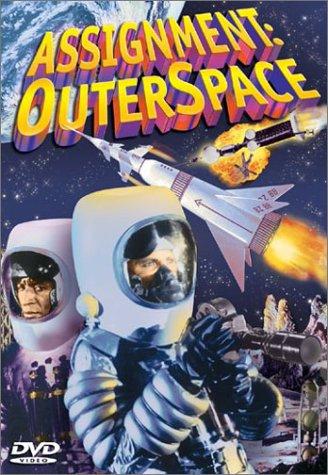
In the year 2116 Rik van Nutter….[ponder that as a stage name] is assigned by the ‘Interplanetary News’ to visit a space station, one of several, it seems, and do a series of human interest articles, about the crew members, their work, life in space. That might seem a reasonable set up.
Here is how it plays. Rik is an insufferable know-it-all, busy-body, girl grabber, and endless pain. He has barely set foot on the station when he starts telling everyone how to do their jobs, getting in the way, and complaining about everything from the soup to the nuts. (Couldn’t resist that one.) After that he gets quarrelsome.
Even the ever whining fraternity brothers grew weary of Rik at 10 minutes and 05 seconds.
His initial meeting with the botanist sums it up. He astounded that the botanist is a woman. He astounded that a woman is a scientist. He is astounded that a woman is an astronaut. He is astounded that a woman is doing vital work. He is astounded that a woman is content to wear the work coverall that all the men wear. He is astounded….
After belittling her work, disparaging her capacities, and insulting her tastes, he turns on the charm and begins to grab and grope her in his state of astoundment. That was then. But what can one say? Has anything changed?
There are some nice shots of weightlessness.
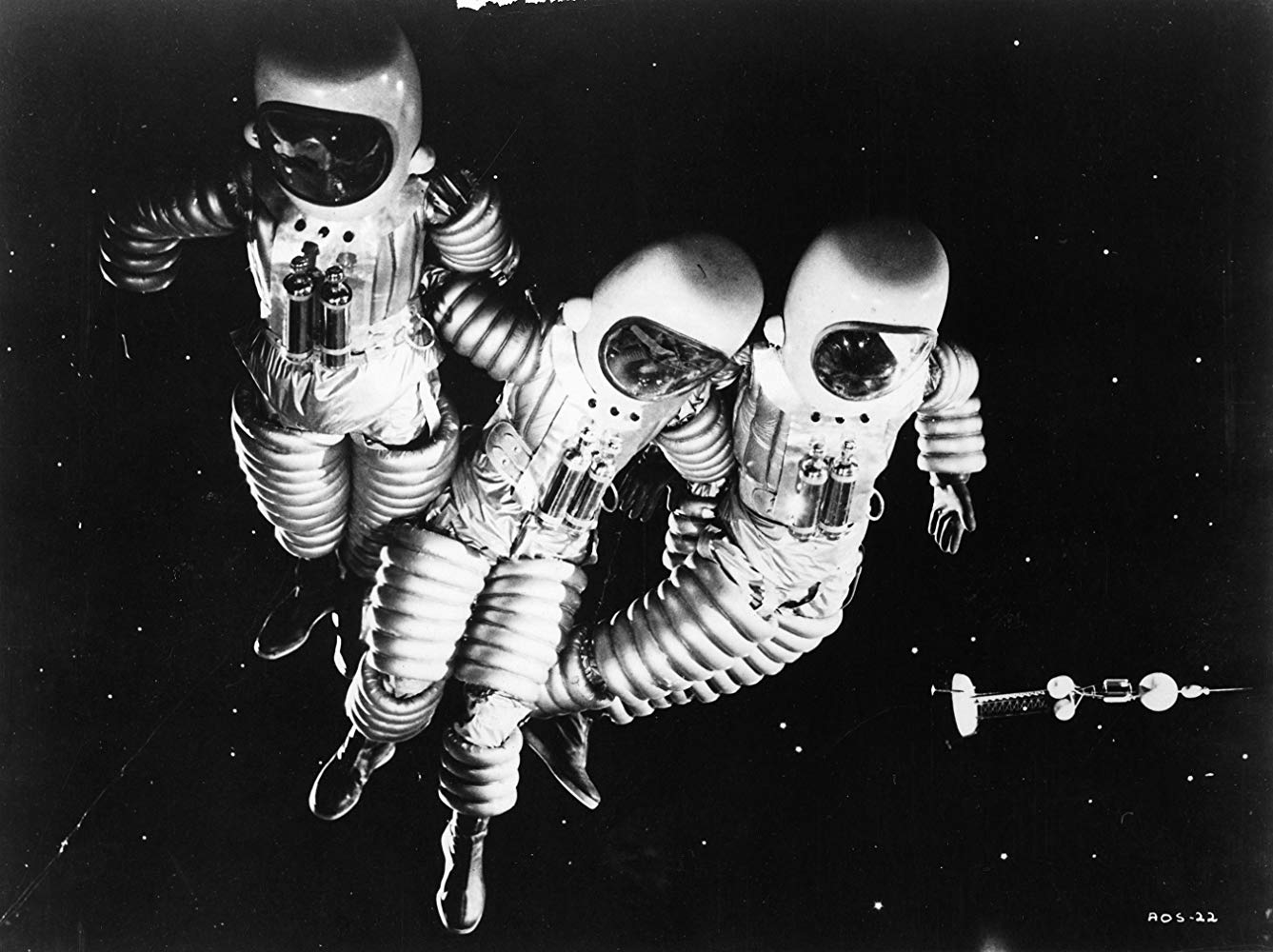
Though why they wear bikers’ helmets all the time is anyone’s guess. Still the white helmets with the dark sun screens make nice images and were cheap to hire.
The station is on a routine maintenance mission when things go wrong. Right on cue the meteors shower up. In part the accident happens because Rik got in the way, but he is sure he saved the day in so doing. In between pouting sessions he declares his heroism and demands a parade in his honour. He goes around expecting to be thanked. He is royally pained to discover the crew is too busy doing important work to celebrate him.
Never does he ask anyone else about themselves, about their work, or write a note. No doubt to complete his story when back on Earth he will interview another journalist and go from there. Some things never change.
To add colour, so often lacking in Sy Fy, Kmoto is there to make sage remarks. He makes the banal lines he has sound important. This one is not all white-bread. Noted.
More things go wrong and this crew has to save the world. None of them are up to the job so Rik has to do it. Ho hum.
This was director Antonio Margheriti’s first solo foray into Sy Fy.

In this outing he took the English pseudonym Anthony Daisies, but Sy Fyians know him better as Anthony Dawson of the Gamma 1 sequence, reviewed elsewhere on this blog. It was with this picture that Mr D proved he could make a movie in ten days for ten lira, and off he went to do for the next fifty years. His last credit was in 2010.
